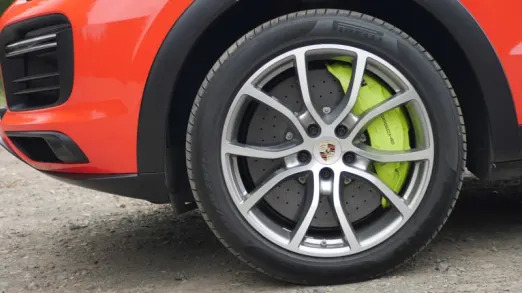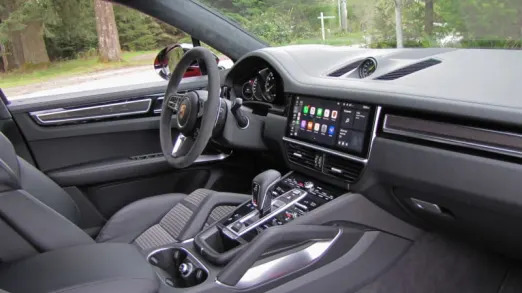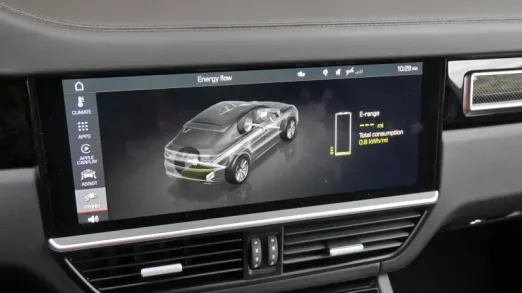"What do you drive?" If you want the answer to that to be quick and easy, forget about this thing. Never mind that this specific car's name is basically a sentence, officially the "2020 Porsche Cayenne Turbo S E-Hybrid Coupe with Lightweight Sport Package in Black," but you have to be prepared to explain what all of that means. You should also want to explain it, because this isn't just a Cayenne and if you say "a Porsche," it seems fair that people are still going to be picturing a 911.
However, since this is a Cayenne Coupe, it at least looks far more like a 911 and therefore a Porsche than any Cayenne that's come before. Whereas the silver Cayenne Turbo we tested last year might as well have been wearing an invisibility cloak, this not-quite-Coupe of many names and resplendent in Lava Orange caught every eye. Yes, the color carries a lot of weight, but even in white, this won't be confused with anything other than a Porsche. This is how the Cayenne should've always looked.


The slime green accents (officially "acid green") in the badging and the enormous brakes are special to the two E-Hybrid models: the standard, more eco-minded version and the Turbo S range-topper that's basically a super group of powertrains. From that standard E-Hybrid, it receives the 100-kilowatt electric motor and 14.1-kWh battery pack. From the Cayenne Turbo, it packs a twin-turbo V8 good for 541 horsepower and 568 pound-feet of torque. Their forces combined, the resulting Turbo S E-Hybrid powertrain produces a certifiably nutty 670 hp and 663 pound-feet.
When using launch control, it'll hit 60 mph in 3.6 seconds. When not using launch control, it'll still hit you in the sternum like a mallet as all that instantaneous torque from the turbochargers and electric motor grab at the pavement through all four sticky summer tires. Your passenger will be thankful for the giant grab handles on either side of their legs; possibly for a good heart as well.
Launching the Turbo S is awfully similar to any number of electric cars in this way, but then it also comes with a lustfully bawdy Sport Exhaust system that rumbles and wails and barks. It's glorious, even if more so from the outside, yet is also a bittersweet reminder that not everything will be better when all cars are electric.
There's also far more to the Turbo S performance credentials than just a 0-60 time. It comes standard with an active air suspension, the Dynamic Chassis Control active roll stabilization powered by the car's 48-volt electrical system, and Porsche's "4-D Chassis Control" that pulls data from myriad vehicle sensors to let everything do their respective magic. This particular car also came equipped with optional rear-wheel steering.
The result is absolutely bonkers. Through a medium-sized hairpin that typically causes tires to squeal as cars wash out in understeer, the Cayenne Coupe stayed flat, stuck like glue and whipped itself around before powering away, its exhaust wailing and its driver plastered to his seatback. Its handling is astonishing. The only downside is that you have to be going awfully fast to start having fun, which is a detriment on most roads. At the same time, and I'm confident this is the first time I've ever written this, it wouldn't be completely pointless and nuts to take this to a track. It would actually be great fun.
Now, if you're expecting something lithe or playful like a 911 or Cayman, this 5,673-pound densely packed behemoth is most definitely not that. Nor does its steering possess the same precision and tactility of those sports cars. However, it's similar in its consistent effort that doesn't change between driving modes (applause) and in general speaks to your hands far more than any of BMW M's hyper SUVs.
As the pinnacle of the Cayenne mountain, however, the Coupe is available with performance-enhancing options not available on the standard body style Cayenne Turbo S E-Hybrid. The Lightweight Sport Packages can shave 70 pounds off the curb weights by removing some sound deadening, fitting forged aluminum wheels and adding a carbon fiber roof in lieu of the standard panoramic sunroof that shaves off 46 pounds alone (that's the amount I quoted in the below above). There are three such packages available, including our middle-ground "in Black" version that carries the nosebleed price of $12,750. The leather seats with Houndstooth cloth inserts can only be paired with a Lightweight Sport Package and are therefore unique to the Coupe version of the Turbo S E-Hybrid. That's too bad, they should be offered on every car sold, but at least they can be added at the extremely un-Porsche price of $0. Well, after you've spent $12,750. The Lava Orange paint goes for $3,150, if you're wondering.
As easy as it is to focus on this uber Cayenne Coupe's performance credentials, it's still a plug-in hybrid that's not only bound to live out its life in suburbia, but do so comfortably, quietly and vastly more efficiently than other ultra-performance SUVs. With a full battery, achieved by plugging in or by the engine itself when using Porsche's unique E-Charge mode, we found the Turbo S E-Hybrid could travel about 15 miles using electricity alone in E-Power mode. That was driving in a perfectly normal way on a simulated suburban commute – mixed speeds on mostly free-flowing surface streets, lots of traffic lights and a brief four-mile interstate stretch. No hypermiling, but also no sternum-thumping launches.
Unlike most hybrids, this one doesn't have any sort of continuously variable transmission. It has a traditional eight-speed automatic, which grants it a perfectly normal acceleration attitude regardless of propulsion source or drive mode. Less normal are the brakes. They're wildly capable, sure, but the pedal can be tough to modulate smoothly in around-town driving. They also curiously require more pedal pressure than normal to keep the car stopped – on more than one occasion I found the car rolling slightly forward despite doing exactly what I always do at stop signs. Initially I thought the cars on either side of me were reversing. Weird. And like the Taycan, this electrified Porsche will not allow for one-pedal driving.




Perhaps that would be anathema to a sporting Porsche as its makers suggest, but it would also add yet another layer to this uniquely Jekyll and Hyde car. It can be a whisper-quiet grocery getter one minute and an angry gobbler of hairpins the next. It can comfortably sit four full-sized adults despite its lower roof and sop up bumps with its magic air suspension, then later ditch the passengers and peacock about with its loud paint, louder exhaust and supercar acceleration.
In a way, it's two cars in one, which is fitting, since it's pretty much priced like two cars – and expensive ones at that. The base price is $164,400 but our generously optioned example goes for $192,590. That revelation should be shocking to all who'll inevitably follow-up "what do you drive" with "how much does it cost?" And it is shocking. A BMW X6 M Competition is only $117,600 and the Mercedes-AMG GLE 63 Coupe only $113,000. On the other hand, the Lamborghini Urus starts at (wipes eyes) $211,321, which possibly makes its German cousin almost seem reasonable? And at least with its electric propulsion, its degree of unapologetic indulgence is lessened. If only that could be said of the amount of words in its name.
Related Video:










Sign in to post
Please sign in to leave a comment.
Continue